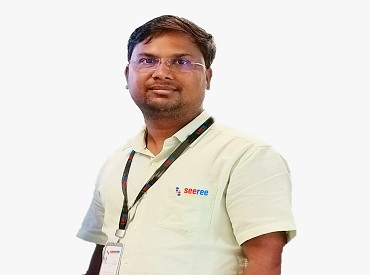Best Java Training Classes
Why Best Java Training Classes in Bhubaneswar at seeree
A class in Java is where we teach objects how to behave. Education at seeree means way to success. The way of teaching by corporate trainers will bloom your career. We have the best java training classes in Bhubaneswar. 100% Placement Support. Job Support Post Training. This course will give you a firm foundation in Java, commonly used programming language.
why seeree is the No.1 institute
- Learn from Corporate Trainer
- Logic Development Class Every Sunday Free
- How to create your resume
- How to maintain your linkedIn / Indeed / naukri
- Update your GIT Repo - By Er. Nagarjun
- Providing Course wise Assessment only at SEEREE
- How to represent yourself in interview - By Er. Swati Srinivas
- Doubt Clear classes anytime everyday
- 100% job assurance
- Experienced Career Consultant - Er. Prabin K Rout / Er. Sritam / Er. Bishnu
- Corporate Syllabus
- Incomparable Syllabus
- Learn from MICROSOFT Certified Professional
- Learn secret step for Campus requirement
- Real Industrial Application of using MVC
- Fully Practical and Interactive Session
- Grooming for Project Demonstration in Campus Interview
- Weekly Workshop on Respective module for Skill Development
- Special Guidance for LIVE Project
- Weekly Online Test for Skill Assessment
- An Earning and Learning Opportunity to all.
- SEO Tips, Study Materials
- Industrial Training from the Leader
- Interview based Q & A discussion
- Free Career consultation
Trainer Profile

Er. Prabin K Rout
CEO at seeree services private limited
M.TECH in Computer Science & Engineering
Freelancing as Corporate Trainer of Muvi , CSM Technology , NIFT , Aspire, HiTech , NIFD, CEB , GIET , GITA , CUTM , Sophitorium
Contact / WhatsApp: 9861693445 Training Email: prabin@seeree.in
Introduction to Java
Java technology is wide used currently. Java is a programming language and it is a platform. Hardware or software environment in which a program runs, known as a platform. Since Java has its own Runtime Environment (JRE) and API, it is called platform. Java programming language is designed to meet the challenges of application development in the context of heterogeneous, network-wide distributed environment. Java is an object-oriented programming (OOP) language that uses many common elements from other OOP languages, such as C++. Java is a complete platform for software development. Java is suitable for enterprise large scale applications.
Dynamically type : before using any variable , if it isn’t required to declare the type of variable , then it is called dynamically typed programming language .
class Simple
{
public static void main(String args[])
{
System.out.println("Hello Java")
}
}
Core Java
1.INTRODUCTION TO JAVA
2.LANGUAGE FUNDAMENTALS
3.DATATYPES AND WRAPPER CLASS
4.OPERATOR, VARIABLE BLOCK AND METHOD IN JAVA
5.CONTROL STRUCTURE USING JAVA
6.OOP
7.METHODS IN JAVA
8.STATIC and STATIC BLOCK
9.CONSTRUCTOR WITH JAVA
10.INHERITANCE
11.POLYMORPHISM
12.ABSTRACT CLASS & INTERFACE
13.RELATIONSHIP
14.PACKAGE
15.ACCESS SPECIFIER
16.ARRAY
17.CHAR,STRING,STRINGBUFFER AND STRINGBUILDER
18.EXCEPTION HANDLING
19.RUNTIME INPUT MECHANISM
20.IO ( FILE HANDLING)
21 - MULTITHREADING & MULTI-PROCESSING
22.DATA STRUCTURE USING JAVA
23.NETWORKING AND SOCKET PROGRAMMING
24.PROGRAMMING USING AWT
25.GUI PROGRAMMING USING SWING
26.GUI PROGRAMMING USING JAVAFX
27.GUI UISNG APPLET
28.EVENT HANDLING
29.REGULAR EXPRESSION AND LAMBDA EXPRESSION
30.DATABASE PROGRAMMING USING JDBC
31.PROJECTS ON J2SE
Introduction to UI & UX
UI refers to the screens, buttons, toggles, icons, and other visual elements that you interact with when using a website, app, or electronic device. UX refers to the entire interaction you have with a product, including how you feel about the interaction.
1. INTRODUCTION
2. Installation and configuring
3.HTML
4.Style Sheet / CSS
5.JavaScript
6. JQuery
7. Ajax
8.JSON
9. REGULAR EXPRESSION
10.Bootstrap
11.FIGMA / PHOTOSHOP
Introduction to Database
A database is simply a structured and systematic way of storing information to be accessed, analyzed, transformed, updated and moved (to other databases).
- Types of Data Base Management Soft and Classification
- Codd's Rule (Golden Rule of Database)
- Pure and significand Difference among DBMS, RDBMS, ORDBMS
- What is Table ?
- What is a Record ?
- What is Field ?
- Super Key
- Candidate Key
- Primary Key
- Composite Key
- Secondary or Alternative key
- Non-key Attribute
- Non-prime Attribute
- Normalization
- Problem Without Normalization
- Normalization Rule
- First Normal Form (1NF)
- Second Normal Form (2NF)
- Third Normal Form (3NF)
- Byte and Code Normal Form (BCNF)
- Relationship
- Binary Relationship
- Recursive Relationship
- Ternary Relationship
- Generalization
- Specialization
- Aggregation
- Introduction to SQL
- DDL : Data Definition Language
- DML : Data Manipulation Language
- TCL : Transaction Control Language
- DCL : Data Control Language
- DQL : Data Query Language
- Creating a Database
- Creating a Table
- Datatype and Magnitude
- Data Type and Magnitude with context to Performance of the Database
- Sub Query and Co Related Sub Queries
- WHERE clause
- Operators (Relational(<,<=,>,>=,=,!=), Logical (And, Or, Not), Like, Between, in ,
- Some, Any ,All
- Order By Clause
- Group By Clause
- HAVING Clause
- Distinct keyword
- Concept of NULL
- SQL Functions
- System Define Procedure / Functions
- Join in SQL (Difference between Pro SQL 99 and SQL 99 Standard)
- Inner Join
- Outer Join
- Left Join
- Right Join
- Full Outer Join
- Self-Join
- Cross Apply
- Outer Apply
- SQL Alias
- SQL View & Common Table Expression
- Materialized View and its Use, with context to views, Different types of View i.e. Classification
- SQL Functions and Procedure and there primary difference , Where what to be imposed
- Exception Handling
- INDEX
- TRIGGER
